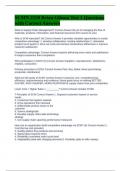SCMN 2150 Brian Gibson Test 1 Questions
with Correct Answers
What is Supply Chain Management? Correct Answer the art of managing the flow of
materials, products, information, and financial resources from source to user.
Why is SCM important? (4) Correct Answer It provides valuable opportunities to create
competitive advantage: 1. develop collaborative, trusting relationships 2. rationalize
product touch points 3. drive out costs and achieve tremendous efficiencies 4. improve
customer satisfaction
Competitive advantage: Correct Answer requires delivering more value and satisfaction
to target consumers than competitors
Who participates in SCM? (5) Correct Answer Suppliers, manufacturers, distributors,
retailers, consumers
Primary processes of SCM: Correct Answer Plan, Buy, Make, Move (purchasing,
production, distribution)
What are the goals of SCM? Correct Answer Customer care, competitiveness,
efficiency, responsiveness and resilience; these goals focus on making BETTER,
FASTER, AND CHEAPER, MORE RESPONSIVE supply chains than your competition.
Lower Cost + Higher Sales = _________? Correct Answer Greater Profits
7 Principles of SCM Correct Answer 1. Segment customers based on service
needs
2. Customize the logistics network
3. Drive operations from demand
4. Differentiate product closer to the
customer
5. Source strategically
6. Develop supply chain-wide technology
strategy
7. Use supply chain spanning performance measures
How can an organization build competitive advantage via SCM? (6) Correct Answer 1.
Cost (be low cost provider)
2. Quality (defect free products and services)
3. Speed (fast response time)
4. Reliability (consistent order cycle time)
5. Adaptability (deal with changing demand) 6. Flexibility (able to offer variety)
, Node Correct Answer a fixed point in a supply chain where goods are processed,
mixed, held, or sold. (plants, warehouses)
Links Correct Answer the transportation method used to connect the nodes in a supply
chain.
Centralized network Correct Answer Management decision making authority is held by
a core group of managers at a single node in the supply chain, as opposed to multiple
nodes. The single node controls customer interaction, the flow of goods, and other key
activities on a national basis.
Centralized networks create (5): Correct Answer lower safety stock,
lower overhead cost (factories, supervisors, managers),
longer lead times,
higher delivery cost,
inefficiencies.
Decentralized network Correct Answer Management decision making authority is given
to the managers at (multiple) individual nodes in the supply chain. Each node controls
customer interaction, the flow of goods, and other key activities within its region.
Decentralized networks create (6): Correct Answer more safety stock,
high overhead cost,
short lead times,
customer service,
low delivery costs,
few economies of scale
Centralized vs. Decentralized Characteristics Correct Answer Centralized:
Distribution- national
Inventory investment- lower
safety stock- lower
inbound transportation costs- lower
outbound transportation costs- higher
service levels- effective
Decentralized:
Distribution: regional
Inventory investment: greater
Safety stock: higher
Inbound transportation cost: higher
outbound transportation cost: lower
service levels: highly effective
What are the three network fulfillment options? Correct Answer Direct delivery, cross
dock, distribution center




